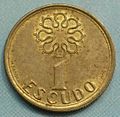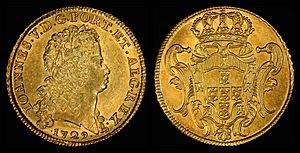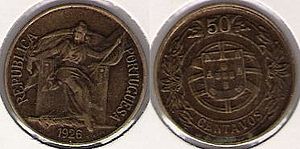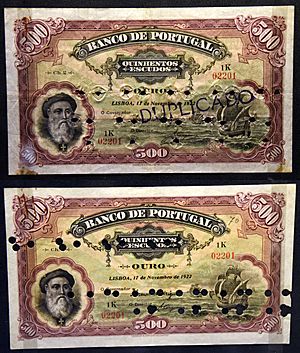Portuguese escudo facts for kids
Quick facts for kids Portuguese escudo |
|||||
|---|---|---|---|---|---|
|
|||||
| ISO 4217 Code | PTE | ||||
| User(s) | None, previously: |
||||
| Inflation | 2.8% (2000) | ||||
| Source | worldpress.org | ||||
| ERM | |||||
| Since | 19 June 1989 | ||||
| Fixed rate since | 31 December 1998 | ||||
| Replaced by €, non cash | 1 January 1999 | ||||
| Replaced by €, cash | 1 January 2002 | ||||
| € = | 200 |
||||
| Subunit | |||||
| 1⁄100 | centavo | ||||
| Symbol | |||||
| Plural | escudos | ||||
| centavo | centavos | ||||
| Coins | |||||
| Freq. used | 1 |
||||
| Banknotes | |||||
| Freq. used | 500 |
||||
The Portuguese escudo was the official money of Portugal. It was used from May 22, 1911, until the euro was introduced on January 1, 2002. One escudo was divided into 100 smaller units called centavos. The word escudo comes from a Latin word meaning "shield".
When writing amounts, people used a special symbol called the cifrão (symbol![]() ). For example, 25
). For example, 25![]() 00 meant 25 escudos and no centavos. 100
00 meant 25 escudos and no centavos. 100![]() 50 meant 100 escudos and 50 centavos.
50 meant 100 escudos and 50 centavos.
Contents
The Escudo's Journey Through Time
The escudo replaced an older currency called the real in 1911. Before that, people used milréis, which was worth 1,000 réis. The change happened after the 1910 Republican revolution in Portugal. One escudo was equal to 1,000 réis.
People often used the old term mil réis as a nickname for the escudo. They also used conto to mean 1,000 escudos. This was because one conto de réis meant one million réis, and since one escudo was 1,000 réis, one conto became 1,000 escudos.
The value of the escudo changed over the years. For example, in 1928, about 108 escudos were worth one British pound. Later, in 1940, about 27 escudos were worth one U.S. dollar.
Over time, prices went up, which is called inflation. This made the small centavo coins almost worthless. Coins like 0![]() 50 and 2
50 and 2![]() 50 were eventually taken out of use in the 1990s. When Portugal joined the Eurozone, 1 euro was worth 200
50 were eventually taken out of use in the 1990s. When Portugal joined the Eurozone, 1 euro was worth 200![]() 482 escudos.
482 escudos.
Where the Escudo Was Used
The escudo was mainly used in mainland Portugal, the Azores islands, and Madeira island. The same coins and banknotes were used in all these places.
The escudo was also used in some of Portugal's former colonies in Africa until they became independent. These included:
- Angolan escudo
- Cape Verdean escudo
- Mozambican escudo
- Portuguese Guinean escudo
- São Tomé and Príncipe escudo
Today, only Cape Verde still uses a currency called the escudo. Other places like Macau and Timor-Leste had their own currencies during the colonial period. Portuguese India also used the Portuguese Indian escudo for a short time.
Coins of the Portuguese Escudo
Many different coins were made for the escudo over its history. Early gold escudos were minted from 1722. In the early 20th century, coins like 0![]() 10, 0
10, 0![]() 20, 0
20, 0![]() 50, and 1
50, and 1![]() 00 were made from silver. Smaller values like 0
00 were made from silver. Smaller values like 0![]() 01 and 0
01 and 0![]() 02 were made from bronze.
02 were made from bronze.
By 1986, a new set of coins was introduced. These coins were used until the euro arrived. The coins in use at that time were:
- 1
 00 (worth about 0.50 euro cents)
00 (worth about 0.50 euro cents) - 5
 00 (worth about 2.49 euro cents)
00 (worth about 2.49 euro cents) - 10
 00 (worth about 4.99 euro cents)
00 (worth about 4.99 euro cents) - 20
 00 (worth about 9.98 euro cents)
00 (worth about 9.98 euro cents) - 50
 00 (worth about 24.94 euro cents)
00 (worth about 24.94 euro cents) - 100
 00 (worth about 49.88 euro cents)
00 (worth about 49.88 euro cents) - 200
 00 (worth about 99.76 euro cents)
00 (worth about 99.76 euro cents)
You could exchange these coins for euros until December 31, 2002.
| Coins of the Portuguese escudo | |||||||||
|---|---|---|---|---|---|---|---|---|---|
| Image | Value | Equivalent in euros | Diameter | Weight | Thickness | Material | Obverse | Reverse | Dates of issue |
| 1 |
0.50 cent | 16 mm | 1.69 g | 1.2 mm | Nickel-brass | Coat of arms of Portugal and knot | Stained glass window pattern | 1986-2001 | |
| 5 |
2.49 cents | 21.1 mm | 5.25 g | 2 mm | Nickel-brass | Coat of arms of Portugal and knot | Stained glass window pattern | 1986-2001 | |
| 10 |
4.99 cents | 23.5 mm | 7.5 g | 2.3 mm | Nickel-brass | Coat of arms of Portugal and knot | Stained glass window pattern | 1986-2001 | |
| 20 |
9.98 cents | 26.5 mm | 6.9 g | 1.64 mm | Copper-nickel | Coat of arms of Portugal | Nautical compass and the cross of the Order of Christ | 1986-2001 | |
| 50 |
24.94 cents | 31 mm | 9.41 g | 1.65 mm | Copper-nickel | Coat of arms of Portugal | Stylized ship and four fishes below | 1986-2001 | |
| 100 |
49.88 cents | 25.5 mm | 8.3 g | 2.5 mm | Bi-metallic coin (Aluminium-bronze center plug with a Copper-nickel outer ring) | Coat of arms of Portugal | Pedro Nunes; text "EUROPA" | 1989-2001 | |
| 200 |
99.76 cents | 28 mm | 9.8 g | 2.2 mm | Bi-metallic coin (Copper-nickel center plug with an Aluminium-bronze outer ring) | Coat of arms of Portugal | Garcia de Orta | 1991-2001 | |
People sometimes used old names for the coins. For example, the 0![]() 50 coin was called a coroa (crown). Even after the coroa disappeared, people still called the 2
50 coin was called a coroa (crown). Even after the coroa disappeared, people still called the 2![]() 50 coin cinco coroas (five crowns).
50 coin cinco coroas (five crowns).
Another old way to talk about money was using the real. So, 2![]() 50 was sometimes called dois e quinhentos (two and five-hundreds). This was because 2
50 was sometimes called dois e quinhentos (two and five-hundreds). This was because 2![]() 50 was equal to 2,500 réis. A tostão was another old term, meaning 100 réis.
50 was equal to 2,500 réis. A tostão was another old term, meaning 100 réis.
Banknotes of the Portuguese Escudo
The Bank of Portugal printed banknotes for various amounts. Early notes included 0![]() 50, 1
50, 1![]() 00, 2
00, 2![]() 50, and up to 1,000
50, and up to 1,000![]() 00. Over time, smaller value notes were replaced by coins.
00. Over time, smaller value notes were replaced by coins.
The last series of banknotes in circulation when the euro was introduced were:
- 500
 00 (worth €2.49)
00 (worth €2.49) - 1,000
 00 (worth €4.99)
00 (worth €4.99) - 2,000
 00 (worth €9.98)
00 (worth €9.98) - 5,000
 00 (worth €24.94)
00 (worth €24.94) - 10,000
 00 (worth €49.88)
00 (worth €49.88)
You could exchange these banknotes for euros at the central bank, Banco de Portugal, until February 28, 2022.
The escudo banknotes often featured important people from Portuguese history. The last series of notes celebrated the Age of Discovery. They showed famous explorers and figures like João de Barros, Pedro Álvares Cabral, Bartolomeu Dias, Vasco da Gama, and Henry the Navigator. The last 100![]() 00 banknote featured Fernando Pessoa, a well-known Portuguese writer and poet.
00 banknote featured Fernando Pessoa, a well-known Portuguese writer and poet.
| Banknotes of the Portuguese escudo (1995–2000 "Portuguese seafarers & explorers" Issue) | ||||||
|---|---|---|---|---|---|---|
| Image | Value | Equivalent in Euros (€) | Main color | Obverse | Reverse | Watermark |
| [1] | 500 |
€2.49 | Olive and Violet | João de Barros | Allegory of the Age of Discovery | João de Barros |
| [2] | 1,000 |
€4.99 | Brown and Purple | Pedro Álvares Cabral | Sailing ship, animals of Brazil | Pedro Álvares Cabral |
| [3] | 2,000 |
€9.98 | Blue and deep blue-green | Bartolomeu Dias; Cruzado coin of Dom João II | Sailing ship, compass card, map | Bartolomeu Dias |
| [4] | 5,000 |
€24.94 | Green and brown-violet | Vasco da Gama | Sailing ship, Vasco da Gama with authorities in Calicut | Vasco de Gama |
| [5] | 10,000 |
€49.88 | Red and dark brown | Henry the Navigator (Infante Dom Henrique) | Sailing ship | Henry the Navigator (Infante Dom Henrique) |
Fun Ways People Talked About Money
People in Portugal had special words for amounts of money.
- Conto: This word was used for 1,000 escudos. For example, if someone said "2 contos", they meant 2,000 escudos. This word came from the older currency, where one conto de réis meant one million réis. Since one escudo was 1,000 réis, one conto became 1,000 escudos. Even after the euro came, some people still used conto to mean €5, which was roughly 1,000 escudos.
- Paus: This word literally means "sticks". People sometimes used it informally to refer to escudos. For example, "Tens mil paus?" meant "Do you have 1,000 escudos/sticks?".
When Portugal switched from escudos to euros, people joked that they had lost three currencies: the escudo, the conto, and the pau.
See also
 In Spanish: Escudo portugués para niños
In Spanish: Escudo portugués para niños
- Portuguese euro coins
- Economy of Portugal
- Economic history of Portugal








